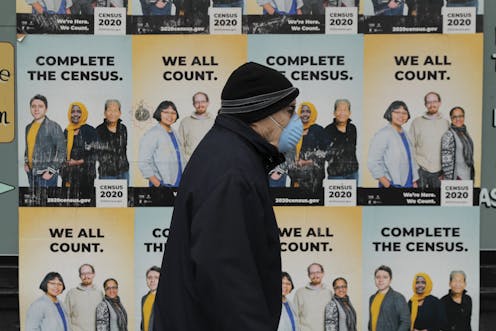Who's at risk of not being counted in the 2020 census: 6 essential reads
- Written by Emily Costello, Deputy Editor, The Conversation US

The census aims to count everyone in the U.S. Of course, that’s not so easy.
Overall, the 2010 census was accurate[1], with a net overcount of just 0.01%. Still, some 16 million people[2] were likely omitted from the final count.
The data that the Census Bureau gathers is used to make important decisions[3] about congressional apportionment and federal funding. So, if one county is undercounted more than another, that may mean that they are less well represented politically, or that they get less than their fair share of money over the next decade.
A few groups are at particular risk of being undercounted.
African Americans
Demographers first realized that the census was not counting everyone equally in World War II, and that places with large nonwhite populations were being underrepresented.
“While the U.S. census has been able to reduce the overall undercount since then, it still disproportionately misses African Americans and other people of color today,” writes Emily Klancher Merchant[4].
Young children
Children under 5 “have proven the hardest group to count,” writes Heather Hanna of Mississippi State University[5], with an estimated 1 million left off the 2010 census.
She notes that “just a 5% undercount of young children in Mississippi would cost the state $100 million in federal dollars per year – for 10 years.”
Native Americans
The census is not well designed for tribal populations, who may live in remote areas, speak a language that the questionnaire is not offered in, or even have names too long to fit on the form.
As Wayne State University’s Kirsten Carlson explains[6], “The Census Bureau estimates that it undercounted American Indians living on reservations and Alaska Natives in villages by approximately 4.9% in 2010.”
Rural Americans
John Green of the University of Mississippi studies response to the census in rural areas[7]. His research found that in the average metropolitan or urban county, 75% of people returned the mailed version of the form. In rural areas, the average was 68%.
“Populations can be hard to count for many reasons,” writes Rebecca Tippett of UNC Chapel Hill[8]. “Some people don’t wish to be found, while others may be hard to contact because they live in gated communities. Others may be hard to interview, due to low literacy or limited English. Finally, some individuals are hard to persuade.”
“Distrust and low participation tends to be highest[9] among groups that have been historically undercounted in previous censuses: young children, renters, people of color and those who live in large households,” adds Jessica Stanford, also of UNC Chapel Hill.
According to a survey run by the U.S. Census Bureau, 13% of Americans are “extremely concerned” that their answers to the 2020 census will be used against them.
Want to learn more about the 2020 census? This is an excerpt from our new email course, which will send informative emails straight to your inbox for three weeks. Sign up here to learn more about how the census affects your community[10].
References
- ^ the 2010 census was accurate (theconversation.com)
- ^ some 16 million people (www.prb.org)
- ^ make important decisions (theconversation.com)
- ^ writes Emily Klancher Merchant (theconversation.com)
- ^ writes Heather Hanna of Mississippi State University (theconversation.com)
- ^ As Wayne State University’s Kirsten Carlson explains (theconversation.com)
- ^ studies response to the census in rural areas (theconversation.com)
- ^ writes Rebecca Tippett of UNC Chapel Hill (theconversation.com)
- ^ Distrust and low participation tends to be highest (theconversation.com)
- ^ Sign up here to learn more about how the census affects your community (theconversation.com)
Authors: Emily Costello, Deputy Editor, The Conversation US


